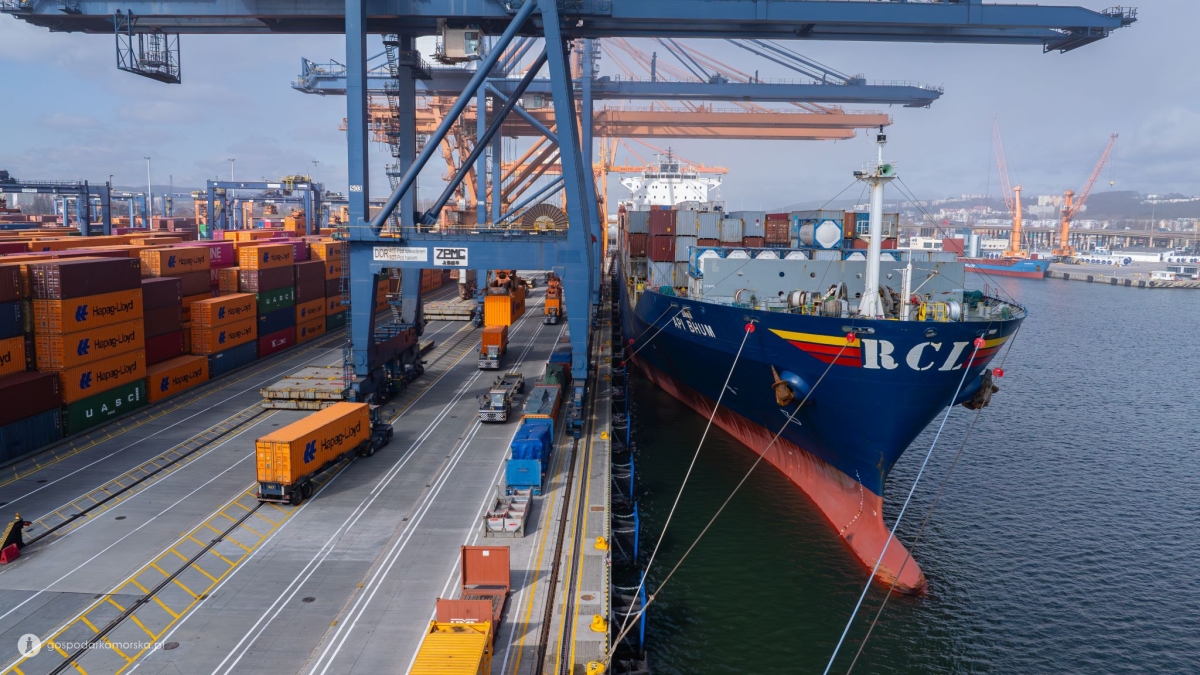
The teams at container terminals in Polish ports will remember March 2025 for a long time—it was a month filled with impressive handling volumes. All terminals recorded increases, and some even broke records.
Polish ports had a successful quarter, with container handling standing out in particular. All container terminals across the country saw clear growth. Moreover, Baltic Hub and BCT both broke monthly handling records in March, while GCT came close to its all-time best.
Baltic Hub
Poland’s largest container terminal and the biggest on the Baltic Sea—Baltic Hub in Gdańsk—set a new record. In March, 222,712 TEUs were handled there, making it the best month in the terminal's history. According to Baltic Hub, this result was driven by a higher number of vessel calls, increased operational efficiency thanks to modern technological solutions, and test operations at the new T3 quay. It is highly likely that the official launch of T3, planned for mid-year, will bring further records.
In total, over 642,000 TEUs were handled in the Port of Gdańsk in Q1 2025—a year-on-year increase of more than 17%.
GCT (Gdynia Container Terminal)
March 2025 will also be remembered fondly by GCT management. It was the second-best month in the terminal’s history. In March alone, the Hutchison-operated Gdynia terminal handled 40,442 TEUs, significantly surpassing the March 2024 result of 30,450 TEUs.
Q1 as a whole was also solid: GCT handled 111,293 TEUs, compared to 87,276 TEUs last year—an increase of 27.52%. Each month showed improvement:
-
January: 32,135 TEUs (vs. 27,139 a year earlier)
-
February: 38,716 TEUs (vs. 29,687 a year earlier)
The Q1 total included 62,215 individual containers, mostly 40-foot units (49,160). Of the total, 150.2 thousand TEUs were import and 110.9 thousand TEUs export.
BCT (Baltic Container Terminal)
Across the harbor channel, BCT also reported excellent results. In Q1, it handled 166,775 TEUs, compared to 131,521 TEUs a year earlier—an increase of 26.8%. March was especially impressive: 61,465 TEUs, up 47.5% from 41,672 TEUs in March 2024. This was likely the terminal’s best-ever monthly result, surpassing the previous record from March 2021 (50,378 TEUs).
In total, BCT handled 100,304 containers in Q1, with a majority being 40-foot units (66,511). It processed 92,210 TEUs for export and 74,565 TEUs for import. Full containers predominated.
OT Port Gdynia
Although smaller in volume, OT Port Gdynia also saw growth—25.1% up year-over-year. In Q1 2024, it handled 375 TEUs; in Q1 2025, it reached 469 TEUs. Unlike the other Gdynia terminals, most containers were 20-foot units—425 of them, compared to just 22 forty-footers.
In total, 447 containers were handled. Imports and exports were nearly evenly split: 249 TEUs for domestic use, 220 TEUs exported. Most of the exported containers were empty (133), while imported ones were predominantly full (201).
March alone brought 158 TEUs, a jump of 81.6% from 87 in March 2024.
DB Port Szczecin
The Szczecin–Świnoujście port complex also plays a role in container handling. In Szczecin, DB Port Szczecin handled 22,612 TEUs in Q1 2025—a 32.3% increase from 17,091 TEUs in Q1 2024. This volume included 11,811 containers, mostly 40-foot and full. Import dominated (12,650 TEUs), with exports accounting for 9,962 TEUs.
In March, throughput rose by 18.1%, from 6,831 TEUs in 2024 to 8,065 TEUs in 2025, involving 4,225 containers.
OT Port Świnoujście
Since February 2025, container handling has also begun at the Hutników Quay in Świnoujście, operated by OT Port Świnoujście. This is made possible by Eimskip vessels from Iceland, which call at Świnoujście every two weeks.
Initial results are promising. In Q1, the terminal handled 1,187 TEUs across 606 containers, mainly 40-footers. Exports accounted for 668 TEUs, imports for 519. Most exported units were empty, while imports were mostly full.
In March alone: 551 TEUs across 283 containers.
Total
In total, Polish ports handled over 944,000 TEUs in Q1 2025—already nearly 28% of the total annual volume from 2024. If this trend continues, 2025 will see a significant increase in annual container throughput. It’s also worth noting that the launch of the new T3 terminal at Baltic Hub, expected mid-year, is set to boost capacity by 1.5 million TEUs.
Let me know if you want this rewritten as a press release, a news summary, or for use in a specific publication.


